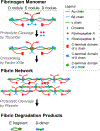Fibrinogen, Fibrin, and Fibrin Degradation Products in COVID-19
- PMID: 36029073
- PMCID: PMC10316333
- DOI: 10.2174/1389450123666220826162900
Fibrinogen, Fibrin, and Fibrin Degradation Products in COVID-19
Abstract
Severe Acute Respiratory Syndrome Coronavirus-2 (SARS-CoV-2) is the highly pathogenic and highly transmissible human coronavirus that is the causative agent for the worldwide COVID-19 pandemic. COVID-19 manifests predominantly as a respiratory illness with symptoms consistent with viral pneumonia, but other organ systems (e.g., kidney, heart, brain) can also become perturbed in COVID-19 patients. Accumulating data suggest that significant activation of the hemostatic system is a common pathological manifestation of SARS-CoV-2 infection. The clotting protein fibrinogen is one of the most abundant plasma proteins. Following activation of coagulation, the central coagulation protease thrombin converts fibrinogen to fibrin monomers, which selfassemble to form a matrix, the primary structural component of the blood clot. Severe COVID-19 is associated with a profound perturbation of circulating fibrinogen, intra- and extravascular fibrin deposition and persistence, and fibrin degradation. Current findings suggest high levels of fibrinogen and the fibrin degradation product D-dimer are biomarkers of poor prognosis in COVID-19. Moreover, emerging studies with in vitro and animal models indicate fibrin(ogen) as an active player in COVID-19 pathogenesis. Here, we review the current literature regarding fibrin(ogen) and COVID-19, including possible pathogenic mechanisms and treatment strategies centered on clotting and fibrin(ogen) function.
Keywords: COVID-19; D-dimer; Fibrinogen; coagulation; fibrin; fibrinolysis.
Copyright© Bentham Science Publishers; For any queries, please email at epub@benthamscience.net.
Conflict of interest statement
CONFLICT OF INTEREST
The authors declare no conflict of interest, financial or otherwise.
Figures



References
Publication types
MeSH terms
Substances
Grants and funding
LinkOut - more resources
Full Text Sources
Other Literature Sources
Medical
Miscellaneous

